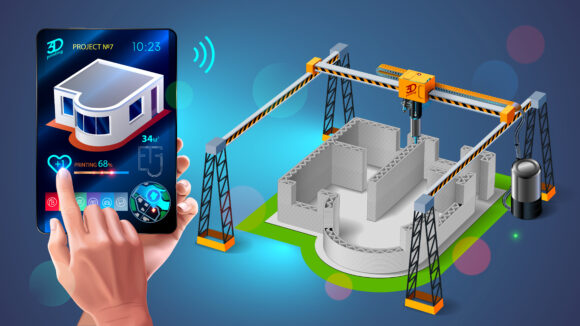Much has been written about concerns related to use of 3D printing in the office or home, including potential risks associated with health, safety, product defects, and more.
Now, imagine taking your 3D printer outside and watching it morph from the size of a milk crate to that of a triceratops — such devices are already a reality; there are currently numerous types of large, 3D printing construction devices that can assist in the building of structures.
What Is 3D Printing?
3D printing is a production technology that can fabricate components, parts and more from a digital blueprint. Through this technology products including medical devices, replicated museum pieces, shoes, food and more are “printed,” layer by layer, using materials such as polymers, metals and ceramics.
Generally, 3D printing begins with the creation of a digital 3D model of the object to be printed using certain software applications. The digital model is then exported into a “stereolithographic” file, which is comprised of digital 2D layers of the object that can be read by the printer.
New Concrete Mixtures
3D printing in construction is still in the early stages, accounting for only about 3% of global projects. Though, there are various construction processes that can be enhanced by 3D printing. For example, contour crafting involves extruding a cementitious mixture from a nozzle that can move along three axes, or from a nozzle attached to a robotic arm. In both cases, the nozzle moves according to the pre-determined model to layer the mixture, eventually forming walls, floors and more.
Some different types of extrudable materials include:
- Concrete with sand and additives
- Concrete with cement and additives
- Concrete with cement, sand, geopolymers and additives
- Concrete with cement, sand, fiber and additives
- Concrete mixed with recycled glass
- Organic materials such as straw, lime, soil, rice and grains
- Clay mixtures from local soil.
Of note, some experts assert that even if fibers are added to increase the ductility and tensile strength of materials, many 3D-printed structures will still need reinforcement bars.
Speed of Construction
Improved efficiency is one of the most notable potential benefits of 3D printing in the construction industry. For example, one project created a complex wall designed with a geometry to improve thermal insulation in about 12-hours. Another project involved the creation of most of the parts of a 250-square-meter office over a period of 17 days, followed by a crew assembling the structure in two days. Finally, all the parts of a 6.5-meter bicycle bridge in the Netherlands were completed within 48 hours.
3D-Printing and Safety
Some researchers assert that 3D printing can be an alternative to bricklaying, concrete casting, and reinforcement installation — which can be dangerous activities — thus possibly reducing the chance for onsite injuries. However, 3D printing needs special concrete mixtures, equipment and labor, and is not currently a cost-effective means to improve worker safety.
Relative to building safety, typically, the structural performance of a building is computed using digital modeling techniques. However, in the case of 3D printed concrete, such models lack validation. Eventually, they should be able to mitigate failures and potential deformations by improving process parameters, part orientation, choice of mixture to ensure proper layer adhesion, and other critical safety metrics.
Notably, modeling 3D printed structures requires tremendous computational power, which may be a significant expense.
Additional Considerations for Insurers
The above examples of how construction processes can change when utilizing 3D printing processes might need to be considered with thinking about impact to professional liability for occupations such as architects, engineers and developers. Other lines of business may need to consider some of the concerns that are associated with 3D printing in general.
For instance, 3D printing may introduce novel legal implications, especially for products liability, because it may not be clear who is actually “the manufacturer,” what “the product is,” what makes up the “the marketplace,” and where the potential liability for a defect falls.
Regarding defects, additional points to consider are:
- Is the defect a result of the original design, a software error, the 3D printer itself, the material, or human error somewhere during the manufacturing process?
- CAD code, or code instructions for the 3D Printer, may be considered a product for the purposes of products liability. Courts have not yet addressed this question directly, but ClearCorrect Operating, LLC v. International Trade Commission 810 F.3d 1283, 1290 (Fed. Cir. 2015), although not a products liability case, held that 3D printing blueprints are not material items.
Cybersecurity risks also exist. As with many digital products, there is a concern with the potential malicious hacking of files used by 3D printers. Hackers could theoretically introduce flaws that may be difficult to detect and increase exposure to product liability risk, among other potential exposures.
In addition, 3D printing typically requires the use of digital blueprints that can potentially be accessed through various methods and copied. Once copied, a 3D printer can potentially replicate the design exactly, which may generate intellectual property concerns.
Example Project
Proponents of 3D printing homes assert that they may eventually cost less than traditional construction methods, and the choice of material can provide homes with greater resiliency.
Currently, lumber and labor costs are still well above pre-pandemic levels. 3D printing offers the ability to choose construction materials other than lumber and can reduce the number of necessary workers.
For example, a project is underway to build 100 single-family homes in Texas using 3D printers. Some of the homes, which will all be single-story, will be as large as 3,000 square feet. The company behind the initiative has built dozens of partially 3D printed homes in America, though this will be by far their largest project.
Notably, the company was recently able to raise over $200 million worth of capital to finance the project.
3D printed homes may be one avenue to help disadvantaged people become homeowners as America is currently suffering from a shortage of nearly 7 million affordable homes. 3D printed homes may have the potential to alleviate some of the pressure caused by the ongoing housing crisis. 3D printed homes are estimated to cost about 15% less to construct than traditionally built homes and, as mentioned, can also be constructed much faster.
Was this article valuable?
Here are more articles you may enjoy.



 Let Good Adjusters, Not Expensive Lawyers, Make the Difference on Claims, CEO Says
Let Good Adjusters, Not Expensive Lawyers, Make the Difference on Claims, CEO Says  Allstate, Nationwide Post Dramatic Q12024 Homeowners Loss Ratio Drops: S&P
Allstate, Nationwide Post Dramatic Q12024 Homeowners Loss Ratio Drops: S&P  Three Charged With Helping Agents Cheat on Florida Insurance License Exams
Three Charged With Helping Agents Cheat on Florida Insurance License Exams  Farmers Adjusters Cry Foul Over Workloads, Claims Handling in Letter to Regulators
Farmers Adjusters Cry Foul Over Workloads, Claims Handling in Letter to Regulators 



